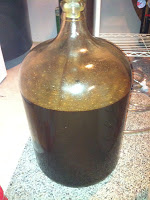
One of the great insights I have gleaned from homebrewing is how complex beers make such rapid progression from when they are brewed. Most breweries will not release beers until they are at their peak in terms of flavor. And if not when they are at their peak, at least after a set amount of time that has allowed the flavors to come together. For example, a complex stout likely will not hit shelves until multiple months following the day it was brewed. The new trend of cellaring beers means that some of these beers can sit in a cool dark place for one to multiple years, but brewers cannot afford to have large inventories sitting around so they release after the flavors have reached some kind of harmony. One of the great things about homebrewing is most home brewers cannot wait to try their creation. These beers often undergo dramatic evolution in a very short time often to the point where it tastes like you are drinking a different beer each week.
I started brewing with a friend 18 or so months ago and our first creation was a Chocolate/Coffee/Oatmeal Stout. This was a style brewed for my wife since she would soon be giving birth to our first child and she hadn’t had a taste of beer in way too long. The date this brew was concocted was on an unseasonably warm fall day in Wisconsin. There were some minor complications during the boil in which a larger than usual volume was lost. An attempt to recover a portion of the lost volume was made prior to entering primary fermentation. Needless to say we did not trust our ABV calculations at that time.
3 Weeks Following Brew Day
The beer was kegged and a final calculation of the ABV showed that we produced a monster of a stout, weighing in at an impressive 10.2%. A couple pints were force carbonated so we could try this dark and mysterious brew. The beer was sampled at around 50°F and this is the first flavor profile:
Coffee to Bitter (from the chocolate) to Heat to Coffee
The head was much darker than anticipated and the coffee aroma quickly overtook any other elements. The coffee flavor rolled over into a deep bitter from the chocolate with almost no sweetness coming through. The next bite was that of the 10.2% alcohol taking hold and lastly finishing back with the coffee again. With young beers like this, the flavors tend to separate themselves out so you can taste each characteristic. The more time a beer is given, these flavors start to flow into each other. Bottom line, this beer definitely needed some time to age.
5 Weeks Following Brew Day
Not long after, my daughter was born and it was time for a celebratory cocktail. In only 2 weeks the flavor profile had moved on:
Coffee to Heat to Coffee
The coffee flavor came through strong right off the nose. The bitterness of the chocolate had melded into the coffee and blended it into the alcohol to smooth things out, almost like the bite of a nice barleywine. In the end, the coffee came back through nice and big.
8 Weeks Following Brew Day
We had finally worked up the nerve to have a few people over for a little party. Three quarters of a pitcher was poured before the tap started to spit and this would be the immediate end of the Three B’s Stout keg.
Sweet to Bitter to Smoky
The last glasses were poured and this brew had come together nicely. Originally a chocolate, coffee, oatmeal stout was later classified as a Coffee Stout. While the coffee flavor was a universal theme throughout, there were some nice variations on the theme. There was a hint of sweetness in the beginning that eventually gave way to the bitterness, which drowned out any alcohol taste that was left. A smoky Sumatran went into the secondary fermenter and that was the flavor that ended it all. Fortunately, I was smart enough to keep 5 bottles for aging.
1 Year Following Brew Day
Our first creation was now 1 year old along with my beautiful daughter. We had 2 bottles in celebration of the event and this beer had definitely made some dramatic changes.
Coffee to Smokey to Fading
The coffee flavor is still the resounding flavor in this brew. The coffee up front has a very noticeable smokiness to it and it really isn’t the most pleasant smokiness. Harsh and dry, but still interesting and accompanied by a bit of bitterness. The only possible source is the Sumatran coffee that went into the secondary. It is a well known fact the coffee tends to fade fairly quickly, but the smokiness came out and didn’t deserve to be standing on its own. The mouth was much more empty than I imagined it would be. Any remnants of the hot/boozy characteristics were gone, which is a little surprising even after aging since this had double digit ABV. Most all the flavor was right up front. Needless to say I was shocked at how far this beer had migrated from where it began.
Am I disappointed? Maybe a little.
Did I have high expectations? Not really.
What do I think is going to happen as this beer ages another year? Coffee will fade a little more, smokiness (which is not great) will be more pronounced.
Do you think it will get better? No way, I bet it went past its prime at around 6 months, but I am too intrigued not to keep it around.
3 bottles of this brew remain. Will be sending along another round of updates in November 2013.